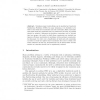Free Online Productivity Tools
i2Speak
i2Symbol
i2OCR
iTex2Img
iWeb2Print
iWeb2Shot
i2Type
iPdf2Split
iPdf2Merge
i2Bopomofo
i2Arabic
i2Style
i2Image
i2PDF
iLatex2Rtf
Sci2ools
94
Voted
CAEPIA
2003
Springer
2003
Springer
Distributed Non-binary Constraints
Nowadays many real problems can be modeled as Constraint Satisfaction Problems (CSPs). In many situations, it is desirable to be able to state both hard constraints and soft constraints. Hard constraints must hold while soft constraints may be violated but as many as possible should be satisfied. Although the problem constraints can be divided into two groups, the order in which these constraints are studied can improve efficiency, particulary in problems with non-binary constraints. In this paper, we carry out a classification of hard and soft constraints in order to study the tightest hard constraints first and to obtain ever better solutions. In this way, inconsistencies can be found earlier and the number of constraint checks can be significantly reduced.
Related Content
| Added | 06 Jul 2010 |
| Updated | 06 Jul 2010 |
| Type | Conference |
| Year | 2003 |
| Where | CAEPIA |
| Authors | Miguel A. Salido, Federico Barber |
Comments (0)

